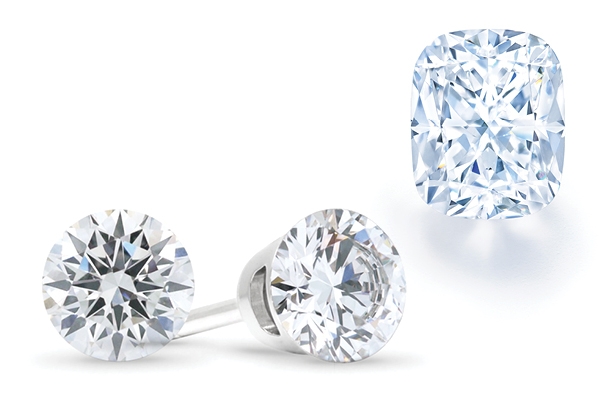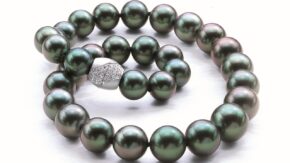With so many brands and suppliers clamoring for business, it’s good to have a niche. Proprietary diamond cuts are a great way to carve out a unique selling point, though they involve costly research and development and can be hard to produce at scale. Protecting the intellectual property is also a difficult task.
Still, demand for original designs exists and is a business opportunity for those who can do it right. Two companies tapped into that in recent months, albeit in different ways. In August 2021, New York-based luxury jeweler Kwiat launched a new take on the cushion cut at the Couture show in Las Vegas. And in December, New Zealand manufacturer and retailer The Village Goldsmith revealed a radical technique for avoiding prongs in ring settings.
Out of shape
The problem with cushion-cut diamonds is that many of them are badly made, says Greg Kwiat, CEO of the company that bears his surname. This partly emanates from the vague industry criteria for the shape: It only needs to be a “squarish, rounded stone,” he points out.
“Our observation was that there are so many poorly cut diamonds in the cushion shape, so many unattractive stones that were being cut,” he explains. “A beautiful cushion is an exceptional diamond, and we wanted to be able to deliver on our brand promise to create and sell only the most beautiful cushion.”
To that end, the jeweler fashioned the Kwiat Cushion. Its elongated shape, the executive believes, makes it more attractive than the squarer versions. And the faceting on the pavilion — the underside of the stone — is standard enough that it still receives a “cushion brilliant” designation on Gemological Institute of America (GIA) grading reports. This was an important consideration: Goods with the word “modified” in the description tend to have a lower price, since the adjustments are usually a way of retaining carat weight or correcting deficient brilliance, Kwiat notes.
The company spent more than a year testing out different ways of slicing the rough. This was a big investment, as the company had to use high-quality rough so it could see and assess the true appearance of the polished outcome, Kwiat relates. “It’s a bit of a trial-and-error process of trying to narrow down the combination of angles and proportions that make for the most beautiful brilliance.”
Soft cushion
Much of the effort went into ensuring that the stone had the desired rounded corners, continues the jeweler. “A lot of cushions today are not soft. They’re very angular. The corners, though rounded, are still quite pointy. The shape, though technically pillow[-like], is very square. So you’ll see a lot of stones that are almost radiant cuts with rounded corners.”
Kwiat is already busy with its next project: to produce its own version of the oval cut. This fits with the company’s preference for refining classic shapes rather than developing totally new ones — though it does sell the Ashoka diamond, a 62-facet proprietary cut.
Most customers, even if they want something different, still seek a diamond that is “classic and timeless” and will retain its value, the CEO says. For example, one of the brand’s trademarked stones is the Kwiat Tiara, which it considers an improved version of the standard round brilliant.
“We have not chosen to create unusual proprietary cuts based on [a particular] number of facets,” he states. In his experience, this “is often a gimmick that does not make the diamond better. It just gives you a selling point that may or may not be worth it. Having the selling point that this is only available here is sometimes a powerful way to proceed. But does that make it a good choice for the customer? Our opinion is, often not.”
Clasp warfare
In 1886, Charles Lewis Tiffany devised a method of lifting a round brilliant diamond off the ring to make it more visible, using six metal prongs. But since the introduction of that Tiffany setting, there have been few major changes to how jewelers place stones in bands, according to Ian Douglas, founder of The Village Goldsmith, which has a retail store in Wellington, New Zealand, and a design studio in Auckland.
“In the close to 50 years that I’ve been in the industry, a constant refrain from clients is, ‘Is there some way you can show the gem — the diamond in particular — without the clasp?’” Douglas says. They “just really want to see the whole diamond.”
Working with Mike Botha, an experienced diamond cutter based in Canada, the company developed a solution in the form of the Floeting Diamond, which lets the stone stand on the setting without clasps to obscure the view.
Pronounced “floating,” the name is based on the word “floe,” a sheet of floating ice. Douglas chose it because it captures the diamond’s hovering appearance, and because “Floating Diamond” would be too generic for the company to protect.
To make it work, the jeweler laser-cuts a groove into the bottom of the diamond and secures it onto the setting. That’s the easy part, according to Botha; the challenge is ensuring that the stone’s quality credentials remain fully intact.
“We had to position it in such a way and design it in such a way that it doesn’t [detract] from the beauty of the diamond, it’s not visible through the crown, and
it doesn’t impede the light performance of the diamond,” Botha explains.
The groove removes less than half a percent of the stone’s weight and has no impact on the color and clarity, he adds. Individual diamonds have already received a Triple Zero score from American Gem Society (AGS) Laboratories — the organization’s best possible cut grade — confirming that the indentation doesn’t reduce the light performance or the appearance, the company notes. The GIA, meanwhile, has agreed to declare Floeting a proprietary cut on grading reports.
Subordinate claws
Douglas also claims the Floeting arrangement is more than 20% stronger than a traditional setting, citing tests by independent parties.
“What we were testing were brand new rings,” he elaborates. “[But] as we’re all well aware, precious metals are soft. When a piece has been worn for 20-plus years, the claws have worn down to such a degree that tehere’s not a lot of metal left holding the stone. A significant portion of jewelers’ business around the world is replacing lost diamonds [where] clasps are worn away and stones just fall out. That can’t happen with our setting.”
Douglas reports “phenomenal” sales so far, especially among men. “It’s really excited the male consumer. They seem absolutely taken with the technology, the fact that it’s new, it’s revolutionary. It takes a classic, traditional, old-style look but makes it modern.”
He intends to expand the offering, introducing new designs, colors and other features. “We are at the tiny, tiny tip of a massive iceberg.”
Image: From left: Floeting; Kwiat



